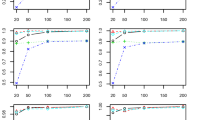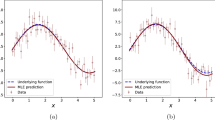Abstract
We introduce a novel rule-based approach for handling regression problems. The new methodology carries elements from two frameworks: (i) it provides information about the uncertainty of the parameters of interest using Bayesian inference, and (ii) it allows the incorporation of expert knowledge through rule-based systems. The blending of those two different frameworks can be particularly beneficial for various domains (e.g., engineering), where even though the significance of uncertainty quantification motivates a Bayesian approach, there is no simple way to incorporate researcher intuition into the model. We validate our models by applying them to synthetic applications: a simple linear regression problem and two more complex structures based on partial differential equations, and we illustrate their use through two cases derived from real data. Finally, we review the advantages of our methodology, which include the simplicity of the implementation, the uncertainty reduction due to the added information and, in some occasions, the derivation of better point predictions, and we outline limitations, mainly from the computational complexity perspective, such as the difficulty in choosing an appropriate algorithm and the added computational burden.






















Similar content being viewed by others
References
Abadi, M., Barham, P., Chen, J., Chen, Z., Davis, A., Dean, J., Devin, M., Ghemawat, S., Irving, G., Isard, M., et al. (2016). Tensorflow: a system for large-scale machine learning. In: 12th \(\{USENIX\}\) symposium on operating systems design and implementation (\(\{OSDI\}\) 16), pp. 265–283
Bar-Sinai, Y., Hoyer, S., Hickey, J., Brenner, M.P.: Learning data-driven discretizations for partial differential equations. Proc. Natl. Acad. Sci. 116(31), 15344–15349 (2019)
Bishop, C.M.: Pattern Recognition and Machine Learning. Springer, Berlin (2006)
Breiman, L., Friedman, J., Stone, C.J., Olshen, R.A.: Classification and Regression Trees. CRC Press, Boca Raton (1984)
Ching, J., Chen, Y.-C.: Transitional Markov chain Monte Carlo method for Bayesian model updating, model class selection, and model averaging. J. Eng. Mech. 133(7), 816–832 (2007)
Chipman, H.A., George, E.I., McCulloch, R.E., et al.: BART: Bayesian additive regression trees. Ann. Appl. Stat. 4(1), 266–298 (2010)
de Boor, C. (1978). A practical guide to spline, volume 27. Springer (New York, NY [ua])
Gelman, A., Carlin, J.B., Stern, H.S., Dunson, D.B., Vehtari, A., Rubin, D.B.: Bayesian Data Analysis. CRC Press, Boca Raton (2013)
González-Díaz, A., Alcaráz-Calderón, A.M., González-Díaz, M.O., Méndez-Aranda, Á., Lucquiaud, M., González-Santaló, J.M.: Effect of the ambient conditions on gas turbine combined cycle power plants with post-combustion CO2 capture. Energy 134, 221–233 (2017)
Hastings, W.K.: Monte Carlo sampling methods using Markov chains and their applications. Biometrika 57(1), 97–109 (1970)
Hoyer, S., Zhuang, J. (2020). Data driven discretizations for solving 2D PDEs. https://github.com/google-research/data-driven-pdes
Kaya, H., Tüfekc\(\dot{i}\), P., Uzun, E. (2019). Predicting CO and NOx emissions from gas turbines: novel data and a benchmark PEMS. Turk. J. Electr. Eng. Comput. Sci. 27(6):4783–4796
Kharratzadeh, M. (2017). Splines in Stan. https://github.com/milkha/Splines_in_Stan/blob/master/splines_in_stan.pdf
Lakshminarayanan, B., Roy, D.M., Teh, Y.W. (2016). Mondrian forests for large-scale regression when uncertainty matters. In: Artificial Intelligence and Statistics, pp. 1478–1487
Lundberg, S.M., Erion, G., Chen, H., DeGrave, A., Prutkin, J.M., Nair, B., Katz, R., Himmelfarb, J., Bansal, N., Lee, S.-I.: From local explanations to global understanding with explainable AI for trees. Nat. Mach. Intell. 2(1), 2522–5839 (2020)
Minson, S., Simons, M., Beck, J.: Bayesian inversion for finite fault earthquake source models I-Theory and algorithm. Geophys. J. Int. 194(3), 1701–1726 (2013)
Nelder, J.A., Mead, R.: A simplex method for function minimization. Comput. J. 7(4), 308–313 (1965)
O’Hagan, A.: Expert knowledge elicitation: subjective but scientific. Am. Stat. 73(sup1), 69–81 (2019)
Pan, I., Bester, D.: Fuzzy Bayesian learning. IEEE Trans. Fuzzy Syst. 26(3), 1719–1731 (2017)
Pan, I., Bester, D.: Marginal likelihood based model comparison in Fuzzy Bayesian Learning. IEEE Trans. Emerg. Topics Comput. Intell. 4(6), 794–799 (2018)
Rasmussen, C.E. (2003). Gaussian processes in machine learning. In: Summer School on Machine Learning, pp. 63–71. Springer
Rochford, A. (2017). A PyMC3 port of Splines in Stan. https://gist.github.com/AustinRochford/d640a240af12f6869a7b9b592485ca15
Salvatier, J., Wiecki, T.V., Fonnesbeck, C.: Probabilistic programming in python using PyMC3. PeerJ Comput. Sci. 2, e55 (2016)
Stan Development Team: RStan: the R interface to Stan. R package version 2(19), 1 (2019)
Tüfekci, P.: Prediction of full load electrical power output of a base load operated combined cycle power plant using machine learning methods. Int. J. Electr. Power Energy Syst. 60, 126–140 (2014)
Acknowledgements
This work was supported by Wave 1 of The UKRI Strategic Priorities Fund under the EPSRC Grant EP/T001569/1, particularly the Digital Twins for Complex Engineering Systems theme within that grant and The Alan Turing Institute. IP acknowledges funding from the Imperial College Research Fellowship scheme. We acknowledge Dr. Daya Shankar Pandey at University of Huddersfield, UK, who is a power plant expert and helped with the rule elicitation in Sect. 4.5.3.
Author information
Authors and Affiliations
Corresponding author
Ethics declarations
Conflict of interest
The authors declare that they have no conflict of interest.
Additional information
Publisher's Note
Springer Nature remains neutral with regard to jurisdictional claims in published maps and institutional affiliations.
Rights and permissions
About this article
Cite this article
Botsas, T., Mason, L.R. & Pan, I. Rule-based Bayesian regression. Stat Comput 32, 44 (2022). https://doi.org/10.1007/s11222-022-10100-7
Received:
Accepted:
Published:
DOI: https://doi.org/10.1007/s11222-022-10100-7




